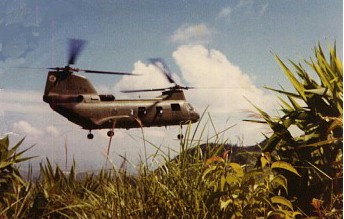No Longer MIA
By Stephen "Tower" Johnson

![]()
No Longer MIA
By Stephen "Tower" Johnson

![]()
In a recent 97 minute phone conversation with Ron LaBar (On), we talked of the times we shared together, especially those members when Ron On was team leader of Team Georgia: Daily, Sechrist, Carey, Cooke, and myself were the other members. I can always recall those missions that were looked forward to. Especially hunter-killers and recon insertions, outside of artillery support, deep into the enemy's back yard.
Then we had those other missions like stay-behinds and radio relay on Hilltop 1362 which in my mind weren't as exciting as the others but necessary. As we are all aware of now, one of the biggest concerns from the Vietnam war were the MIA's, many of whom were pilots that flew support missions for us. This is a narrative of a body recovery mission.
One day while enjoying ourselves on the beaches of Chu Lai, a composite team of Georgia and Oklahoma was assigned to recover two pilots from a RF (reconnaissance fighter)-4 Phantom that crashed into a mountain side. Quick overflight, test fire, and we were on our way late that afternoon. We decided on an lz (small grass opening) about a km on high ground with the crash site between the insertion and extraction lz located about a half km downhill from the mishap. Rapelling was ruled out because of the possibility of getting fired on. We would start from high ground and move downhill to the site for our mission: recover bodies and blow up the tail section of the RF-4.
There was about an hours worth of sunlight left when we were inserted. After a brief time waiting at the lz, listening for enemy movement which we detected none, we started down the mountain. About 400 meters downhill, we smelled the enemy. A base camp? Upon a careful approach we saw it. The camp was recently deserted, hidden under triple canopy with running water via bamboo chutes with spigots. Several hooches with other things we might have reconned, but our mission was to get the bodies of the pilots out before the enemy took them (psychological ploy that the NVA did at times).
Off to the side, still moving downhill, we moved to our night position. We traded off security duties until daylight always keeping one ear and eye open, wondering what happened to the guys who abandoned their base camp.
At dawn we started towards the crash site with purpose and caution. Over one small ridge we barely spotted a wreckage of a helicopter that had been devoured by the jungle. Ron called in the tail number of the Marine or Navy transport and we then moved another 200 meters where we saw the Phantom crash site. Before and after moving in, we observed the high ground above us looking for the green flashes of an AK. None that day!
We found the first pilot, put him in a body bag, but couldn't find the second. Called for a huey that lowered a cable end that took the marine pilot out. Then we got a call to secure the extraction site for a VIP Marine-Navy medical and aviation team. Georgia and Oklahoma did and the photo, shown above, was the chopper that brought in Marine and Navy personnel. Cooke and I stayed at the extraction lz and the other members led the contingency to the wreckage sites where whatever remains could be found were recovered including the other pilot that was in the RF-4, thanks to the help of the Navy and Marines. The chopper transport crashed several years prior to the phantom crash with many on board. 2,102 MIAs to this day still haven't been accounted for. We accounted for several that day in the fall of 1969 in I Corps.
![]()